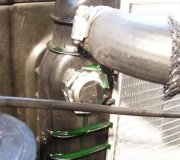When I can't think of a logical answer, it is usually because it has something do with lowering emissions a tiny little bit at the potential expense of a few overheated engines. In case you haven't picked up on it, I have very little respect for car designers and even less for the unknowlegeable politicians who make laws the rest of us have follow.
Higher cylinder temperatures promote more complete combustion of fuel, and therefore, lower emissions. Pistons are oval-shaped and grow to fit the cylinders at the temperature they're designed to run at. Running at a lower temperature will greatly increase cylinder wear due to the poorly-fitting pistons. Contaminants in oil won't boil off as easily at lower temperatures resulting in more sludge. You'll actually do more damage through accelerated wear running at 195 than at 220 degrees.
Remember too the fan isn't needed at highway speed. Natural air flow takes care of the radiator. The thermostat sets the operating temperature, and the fan only comes into the picture at very slow speeds or when standing still. The fan on my '88 Grand Caravan turned on very rarely and only on hot summer days during prolonged idle.
Thursday, March 24th, 2016 AT 9:40 PM


